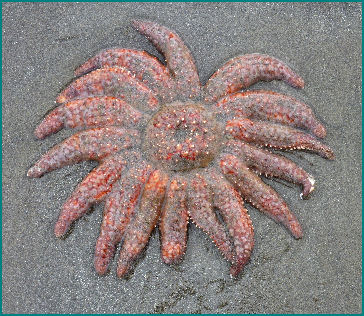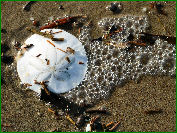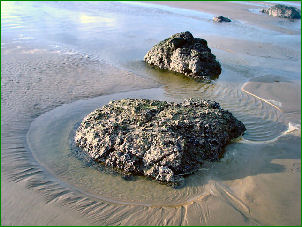BEACHCOMBERS BLOG

The sea is always depositing fascinating things on our shores.
Forever changing, always something new.
I plan to share some of my discoveries here, and I hope you'll
share yours too!
One foggy fall morning, I discovered a very bright orange starfish at the tide line. It was unusual for its 16 arms! It's called the "SUNFLOWER STAR," the largest sea star in the PNW, and one of the largest in the world. This fellow is a voracious and speedy carnivore. found up and down the Pacific coast from Alaska to California. These clustered stars have been found to be feeding on barnacles and mussels and seem to enter a state of low activity during the cold winter months.
 Without question this is the “king” of Pacific coast sea stars. Unlike most, it has a soft, flexible skeleton that gives it surprising agility. The sunflower star is also "quick on its tube-feet," capable of sprinting at up to 2.1 m/min (6.9 ft/min), runner-up only to the “Olympic” champion, the sand star. The number of tube-feet possessed by a large specimen is reportedly 20,000 or more.
When the sunflower star first settles from the plankton to live on the sea floor it has five arms just like most other stars. As it grows, additional arms sprout quickly, ultimately ending up with as many as 20 or more gracefully tapering arms radiating from its broad central disc. All those arms and bulky body require the sunflower star to feed often and lots of different prey. But having more arms can also be an advantage when attacking fast-moving or elusive quarry.
Without question this is the “king” of Pacific coast sea stars. Unlike most, it has a soft, flexible skeleton that gives it surprising agility. The sunflower star is also "quick on its tube-feet," capable of sprinting at up to 2.1 m/min (6.9 ft/min), runner-up only to the “Olympic” champion, the sand star. The number of tube-feet possessed by a large specimen is reportedly 20,000 or more.
When the sunflower star first settles from the plankton to live on the sea floor it has five arms just like most other stars. As it grows, additional arms sprout quickly, ultimately ending up with as many as 20 or more gracefully tapering arms radiating from its broad central disc. All those arms and bulky body require the sunflower star to feed often and lots of different prey. But having more arms can also be an advantage when attacking fast-moving or elusive quarry.
The sunflower star eats just about anything in its path. Its prey include green and red sea urchins, clams dug from sandy substrates by excavating large pits, scallops, abalone, snails, barnacles and occasionally, other sea stars. This star has a very large, eversible cardiac stomach that can envelop and digest prey outside its body.
Several creatures exhibit striking escape responses when attacked by a hunting sunflower star. The NORTHERN ABALONE twists its shell violently and glides away on its muscular foot, and the NUTTALL'S COCKLE extends its spring-like muscular foot and forcefully pole-vaulting itself away from the predator.
When attacked by a relative called the MORNING SUN STAR, the SUNFLOWER STAR can deliberately cast off (a process known as autotomy) an entire ray, making good its escape by sacrificing a single ray to the predator. This ability is possible due to specialized connective tissue that can rapidly change its tensile strength. Look carefully at the picture and you'll see a single arm being autotomized.

